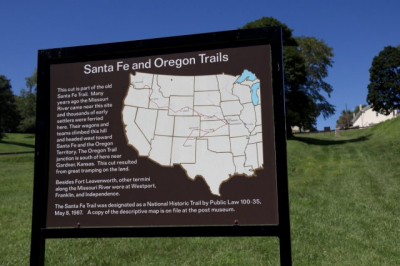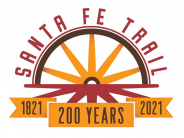Santa Fe Trail and Oregon-California Trails
"Trails West"
The Missouri River and the original boat landing at Fort Leavenworth are at the foot of the hill just off of Riverside Dr. just beyond the railroad track. A ferry at the base of this hill connected to the immigrant road, which led to Liberty, Missouri. Within two years of its founding, Fort Leavenworth was connected to the outside world by regular steamboat service. The boats unloaded near the ferry-landing site. Military supplies were kept in a warehouse at the base of the hill and later transferred to the Quartermaster Supply Depot within what is now the confines of the United States Disciplinary Barracks. The cut or swale, which remains in the hillside today, was made by the hundreds of wagons of supplies pulled by teams of oxen or horses that were hauled up this hillside. Although civilian traders and settlers used this branch, it was primarily a military route. Everything that supplied Fort Leavenworth and the forts to the west, from the smallest button to the largest cannon, was shipped along this route. Originally the Santa Fe and military road traffic would head south down what is now Grant Avenue, eventually crossing the Kansas (Kaw) River at Grinter Ferry in Kansas City, Kansas, then head due south to Fort Scott, KS or due west on the Santa Fe Trail.
The Oregon-California Trail supply wagons moved due west along what is now Kearny Avenue, cutting across Doniphan Field and the National Cemetery, eventually exiting the north side of the post through a gap in the hills behind the Kansa Village housing area. When Fort Riley, KS was established, supply trains left Fort Leavenworth for the Oregon-California Trail route, but then followed the north bank of the Kaw River along the Fort Riley military road. At Fort Riley, supplies bound for the Oregon Trail went north and those bound for the Santa Fe Trail went south.
When rail service was established after the Civil War, the steamboats and wagon supply trains became obsolete.




